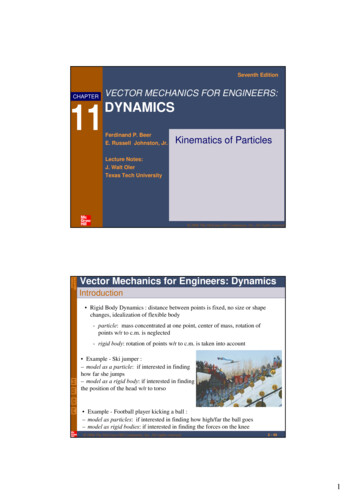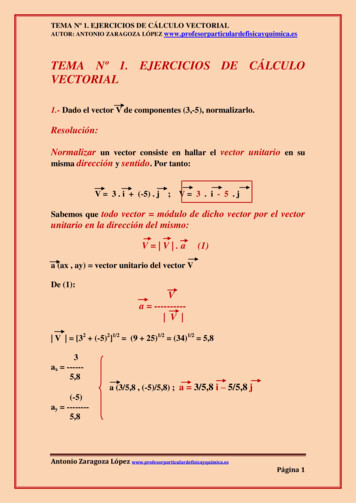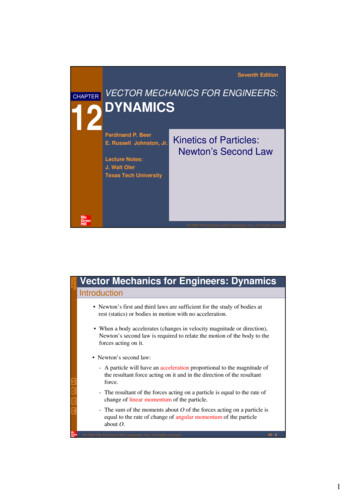
Transcription
Seventh EditionCHAPTER11VECTOR MECHANICS FOR ENGINEERS:DYNAMICSFerdinand P. BeerE. Russell Johnston, Jr.Kinematics of ParticlesLecture Notes:J. Walt OlerTexas Tech University 2004 The McGraw-Hill Companies, Inc. All rights reserved.SeventhEditionVector Mechanics for Engineers: DynamicsIntroduction Rigid Body Dynamics : distance between points is fixed, no size or shapechanges, idealization of flexible body- particle: mass concentrated at one point, center of mass, rotation ofpoints w/r to c.m. is neglected- rigid body: rotation of points w/r to c.m. is taken into account Example - Ski jumper :– model as a particle: if interested in findinghow far she jumps– model as a rigid body: if interested in findingthe position of the head w/r to torso Example - Football player kicking a ball :– model as particles: if interested in finding how high/far the ball goes– model as rigid bodies: if interested in finding the forces on the knee 2004 The McGraw-Hill Companies, Inc. All rights reserved.2 - 491
SeventhEditionVector Mechanics for Engineers: DynamicsIntroduction Dynamics includes:- Kinematics: study of the geometry of motion. Kinematics is used torelate displacement, velocity, acceleration, and time without reference tothe cause of motion, i.e. forces are not considered.- Kinetics: study of the relations existing between the forces acting on abody, the mass of the body, and the motion of the body. Kinetics is usedto predict the motion caused by given forces or to determine the forcesrequired to produce a given motion. Newton’s laws:1.F 02.F ma3.Action-reaction 2004 The McGraw-Hill Companies, Inc. All rights reserved.3 - 49SeventhEditionVector Mechanics for Engineers: DynamicsDerivatives of Functions Let s(u) be a scalar function of scalar variable u, sdss (u u ) s (u ) lim limdu u 0 u u 0 ur Let P(u ) be a vector function of scalar variable u,rrrrdPP(u u ) P(u ) P lim limdu u 0 u u 0 u 2004 The McGraw-Hill Companies, Inc. All rights reserved.4 - 492
SeventhEditionVector Mechanics for Engineers: DynamicsPosition, Velocity & Acceleration Consider a particle moving along a certain path Position vector of a particle at time t is defined by avector between origin O of a fixed reference frame andthe position occupied by particle.rr′ Consider particle which occupies position P definedrrby r at time t and P’ defined by r ′ at t t,rr r drr r rrv lim r r ′ rdt t 0 t instantaneous velocity (vector)v lim s t 0 t dsdt instantaneous speed (scalar) Velocity vector is always tangent to particle path. 2004 The McGraw-Hill Companies, Inc. All rights reserved.5 - 49SeventhEditionVector Mechanics for Engineers: DynamicsPosition, Velocity & Accelerationr Consider velocity v of particle at time t and velocityrv′ at t t,rr v dvra lim dt t 0 t instantaneous acceleration (vector) In general, acceleration vector is not tangent toparticle path. 2004 The McGraw-Hill Companies, Inc. All rights reserved.6 - 493
SeventhEditionVector Mechanics for Engineers: DynamicsMotion of a particle along a straight line The motion of a particle is known if position is known for all time t. If path is a straight line we have rectilinear motion, we can describe themotion in terms of a, v and x. Typically, conditions of motion are specified by the type of accelerationexperienced by the particle. Determination of velocity and position requirestwo successive integrations. Three classes of motion may be defined for:- acceleration given as a function of time, a f(t)- acceleration given as a function of position, a f(x)- acceleration given as a function of velocity, a f(v) 2004 The McGraw-Hill Companies, Inc. All rights reserved.7 - 49SeventhEditionVector Mechanics for Engineers: DynamicsMotion of a particle along a straight line Acceleration given as a function of time, a f(t):v (t )tdv a f (t )dv f (t ) dtdv f (t ) dt dt0vdx v(t )dtx (t )dx v(t ) dttv(t ) v0 f (t ) dt00t dx v(t ) dtx0tx(t ) x0 v(t ) dt00 Acceleration given as a function of position, a f(x):v dxdxor dt dtvv dv f ( x )dxa v( x )dvdvor a v f ( x )dtdxx v dv f ( x )dxv0x0 2004 The McGraw-Hill Companies, Inc. All rights reserved.1 v ( x )22 12 v02 x f ( x )dxx08 - 494
SeventhEditionVector Mechanics for Engineers: DynamicsMotion of a particle along a straight line Acceleration given as a function of velocity, a f(v):dv a f (v )dtv (t )dv dtf (v )dvt dt v0 f (v ) 0dv t v0 f (v )vv (t )dv a f (v )dxdx v (t )v dvx(t ) x0 v f (v )v dvf (v )x (t )v (t )v dv dx f (v )x0v00 2004 The McGraw-Hill Companies, Inc. All rights reserved.9 - 49SeventhEditionVector Mechanics for Engineers: DynamicsUniform Rectilinear MotionFor particle in uniform rectilinear motion, the acceleration is zero andthe velocity is constant.dx v constantdtxtx00 dx v dtx x0 vtx x0 vt 2004 The McGraw-Hill Companies, Inc. All rights reserved.10 - 495
SeventhEditionVector Mechanics for Engineers: DynamicsUniformly Accelerated Rectilinear MotionFor particle in uniformly accelerated rectilinear motion, the acceleration ofthe particle is constant.dv a constantdtvtv00 dv a dtv v0 atv v0 atdx v0 atdtx xtx00 dx (v0 at )dtx x0 v0 t 12 at 2x0 v0 t 12 at 2vdv a constantdxv2 v02vxv0x0 v dv a dx12(v 2 v02 ) a(x x0 ) 2 a ( x x0 ) 2004 The McGraw-Hill Companies, Inc. All rights reserved.11 - 49SeventhEditionVector Mechanics for Engineers: DynamicsGraphical Solution of Rectilinear-Motion Problems Given the x-t curve, the v-t curve is equal tothe x-t curve slope. Given the v-t curve, the a-t curve is equal tothe v-t curve slope. 2004 The McGraw-Hill Companies, Inc. All rights reserved.12 - 496
SeventhEditionVector Mechanics for Engineers: DynamicsGraphical Solution of Rectilinear-Motion Problems Given the a-t curve, the change in velocity between t1 and t2 isequal to the area under the a-t curve between t1 and t2. Given the v-t curve, the change in position between t1 and t2 isequal to the area under the v-t curve between t1 and t2. 2004 The McGraw-Hill Companies, Inc. All rights reserved.13 - 49SeventhEditionVector Mechanics for Engineers: DynamicsSample Problem 11.2SOLUTION: Integrate twice to find v(t) and y(t). Solve for t at which velocity equalszero (time for maximum elevation)and evaluate corresponding altitude.Ball tossed with 10 m/s vertical velocityfrom window 20 m above ground. Solve for t at which altitude equalszero (time for ground impact) andevaluate corresponding velocity.Determine: velocity and elevation above ground attime t, highest elevation reached by ball andcorresponding time, and time when ball will hit the ground andcorresponding velocity. 2004 The McGraw-Hill Companies, Inc. All rights reserved.14 - 497
SeventhEditionVector Mechanics for Engineers: DynamicsSample Problem 11.2SOLUTION: Integrate twice to find v(t) and y(t).dv a 9.81 m s 2dtv (t )tv(t ) v0 9.81t dv 9.81 dtv00v(t ) 10dy v 10 9.81tdty (t )t dy (10 9.81t )dty00m m 9.81 2 ts s y (t ) y0 10t 12 9.81t 2m m y (t ) 20 m 10 t 4.905 2 t 2 s s 2004 The McGraw-Hill Companies, Inc. All rights reserved.15 - 49SeventhEditionVector Mechanics for Engineers: DynamicsSample Problem 11.2 Solve for t at which velocity equals zero and evaluatecorresponding altitude.v(t ) 10m m 9.81 2 t 0s s t 1.019 s Solve for t at which altitude equals zero and evaluatecorresponding velocity.m m y (t ) 20 m 10 t 4.905 2 t 2 s s m m y 20 m 10 (1.019 s ) 4.905 2 (1.019 s )2s s y 25.1 m 2004 The McGraw-Hill Companies, Inc. All rights reserved.16 - 498
SeventhEditionVector Mechanics for Engineers: DynamicsSample Problem 11.2 Solve for t at which altitude equals zero andevaluate corresponding velocity.m m y (t ) 20 m 10 t 4.905 2 t 2 0 s s t 1.243 s (meaningless )t 3.28 sv(t ) 10m m 9.81 2 ts s v(3.28 s ) 10m m 9.81 2 (3.28 s )s s v 22.2 2004 The McGraw-Hill Companies, Inc. All rights reserved.ms17 - 49SeventhEditionVector Mechanics for Engineers: DynamicsSample Problem 11.3SOLUTION:a kv Integrate a dv/dt -kv to find v(t). Integrate v(t) dx/dt to find x(t).Brake mechanism used to reduce gunrecoil consists of piston attached to barrelmoving in fixed cylinder filled with oil.As barrel recoils with initial velocity v0,piston moves and oil is forced throughorifices in piston, causing piston andcylinder to decelerate at rate proportionalto their velocity. Integrate a v dv/dx -kv to findv(x).Determine v(t), x(t), and v(x). 2004 The McGraw-Hill Companies, Inc. All rights reserved.18 - 499
SeventhEditionVector Mechanics for Engineers: DynamicsSample Problem 11.3SOLUTION: Integrate a dv/dt -kv to find v(t).v (t )tv(t )dvdv kv k dtln kta v0vdtv00v(t ) v0 e kt Integrate v(t) dx/dt to find x(t).dxv(t ) v0 e ktdttx (t )t 1 kt kt()dxvedtxtve 0 0 k000(vx(t ) 0 1 e ktk 2004 The McGraw-Hill Companies, Inc. All rights reserved.)19 - 49SeventhEditionVector Mechanics for Engineers: DynamicsSample Problem 11.3 Integrate a v dv/dx -kv to find v(x).a vdv kvdxdv k dxvxv00 dv k dxv v0 kxv v0 kx Alternatively,withandthen(vx(t ) 0 1 e ktk)v(t )v(t ) v0 e kt or e kt v0v0 v(t ) x(t ) 1 k v0 2004 The McGraw-Hill Companies, Inc. All rights reserved.v v0 kx20 - 4910
SeventhEditionVector Mechanics for Engineers: DynamicsMotion of Several Particles: Dependent Motion Position of a particle may depend on position of oneor more other particles. Position of block B depends on position of block A.Since rope is of constant length, it follows that sum oflengths of segments must be constant.x A 2 x B constant (one degree of freedom) Positions of three blocks are dependent.2 x A 2 x B xC constant (two degrees of freedom) For linearly related positions, similar relations holdbetween velocities and accelerations.dxdx Adx 2 B C 0 or 2v A 2v B vC 0dtdtdtdv Adv B dvC2 2 0 or 2a A 2a B aC 0dtdtdt2 2004 The McGraw-Hill Companies, Inc. All rights reserved.21 - 49SeventhEditionVector Mechanics for Engineers: DynamicsSample Problem 11.5SOLUTION: Define origin at upper horizontal surfacewith positive displacement downward. Collar A has uniformly acceleratedrectilinear motion. Solve for accelerationand time t to reach L. Pulley D has uniform rectilinear motion.Pulley D is attached to a collar whichCalculate change of position at time t.is pulled down at 3 in./s. At t 0,collar A starts moving down from K Block B motion is dependent on motionsof collar A and pulley D. Write motionwith constant acceleration and zerorelationship and solve for change of blockinitial velocity. Knowing thatB position at time t.velocity of collar A is 12 in./s as itpasses L, determine the change in Differentiate motion relation twice toelevation, velocity, and accelerationdevelop equations for velocity andof block B when block A is at L.acceleration of block B. 2004 The McGraw-Hill Companies, Inc. All rights reserved.22 - 4911
SeventhEditionVector Mechanics for Engineers: DynamicsSample Problem 11.5SOLUTION: Define origin at upper horizontal surface withpositive displacement downward. Collar A has uniformly accelerated rectilinearmotion. Solve for acceleration and time t to reach L.v 2A (v A )02 2a A [x A ( x A )0 ]2 in. 12 2a A (8 in.) s aA 9in.s2v A (v A )0 a At12in.in. 9 2tsst 1.333 s 2004 The McGraw-Hill Companies, Inc. All rights reserved.23 - 49SeventhEditionVector Mechanics for Engineers: DynamicsSample Problem 11.5 Pulley D has uniform rectilinear motion. Calculatechange of position at time t.x D ( x D )0 v D t in. x D ( x D )0 3 (1.333 s ) 4 in. s Block B motion is dependent on motions of collarA and pulley D. Write motion relationship andsolve for change of block B position at time t.Total length of cable remains constant,x A 2 x D x B ( x A )0 2( x D )0 ( x B )0[x A ( x A )0 ] 2[x D ( x D )0 ] [x B (x B )0 ] 0(8 in.) 2(4 in.) [x B ( x B )0 ] 0x B ( x B )0 16 in. 2004 The McGraw-Hill Companies, Inc. All rights reserved.24 - 4912
SeventhEditionVector Mechanics for Engineers: DynamicsSample Problem 11.5 Differentiate motion relation twice to developequations for velocity and acceleration of block B.x A 2 x D x B constantv A 2v D v B 0 in. in. 12 2 3 v B 0 s s v B 18in.sa A 2a D a B 0 in. 9 2 vB 0 s in.a B 9 2s 2004 The McGraw-Hill Companies, Inc. All rights reserved.25 - 49SeventhEditionVector Mechanics for Engineers: DynamicsRectangular Components of Velocity & Acceleration When position vector of particle P is given by itsrectangular components,rrrrr xi y j zk Velocity vector,rrrr dx r dy r dz rv i j k x&i y& j z&kdtdtdtrrr vx i v y j vz k Acceleration vector,rrrr d 2 xr d 2 y r d 2 z ra 2 i 2 j 2 k &x&i &y& j &z&kdtdtdtrrr ax i a y j az k 2004 The McGraw-Hill Companies, Inc. All rights reserved.26 - 4913
SeventhEditionVector Mechanics for Engineers: DynamicsRectangular Components of Velocity & Acceleration Rectangular components particularly effectivewhen component accelerations can be integratedindependently, e.g., motion of a projectile,a x &x& 0a y &y& ga z &z& 0with initial conditions,(v x )0 , (v y ) , (v z )0 0x0 y 0 z 0 00Integrating twice yieldsv x (v x )0x (v x )0 t( )( )0v y v y gt0y v y y 12 gt 2vz 0z 0 Motion in horizontal direction is uniform. Motion in vertical direction is uniformly accelerated. Motion of projectile could be replaced by twoindependent rectilinear motions. 2004 The McGraw-Hill Companies, Inc. All rights reserved.27 - 49SeventhEditionVector Mechanics for Engineers: DynamicsSample Problem 11.7 2004 The McGraw-Hill Companies, Inc. All rights reserved.28 - 4914
SeventhEditionVector Mechanics for Engineers: DynamicsTangential and Normal Components Velocity vector of particle is tangent to path ofparticle. In general, acceleration vector is not.Wish to express acceleration vector in terms oftangential and normal components.rr et and et′ are tangential unit vectors for theparticle path at P and P’. When drawn withr r rrespect to the same origin, et et′ et and θ is the angle between them. et 2 sin ( θ 2 )r etsin ( θ 2 ) rrlimen en lim θ 0 θ θ 0 θ 2rderen tdθ 2004 The McGraw-Hill Companies, Inc. All rights reserved.29 - 49SeventhEditionVector Mechanics for Engineers: DynamicsTangential and Normal Componentsrr With the velocity vector expressed as v vetthe particle acceleration may be written asrrrde dv rde dθ dsr dv dv ra et v et vdt dtdt dtdθ ds dtbut rdet rds enρ dθ ds vdtdθAfter substituting,dvv2r dv r v 2 ra et enat an ρρdtdt Tangential component of acceleration reflectschange of speed and normal component reflectschange of direction. Tangential component may be positive ornegative. Normal component always pointstoward center of path curvature. 2004 The McGraw-Hill Companies, Inc. All rights reserved.30 - 4915
SeventhEditionVector Mechanics for Engineers: DynamicsTangential and Normal Components Relations for tangential and normal accelerationalso apply for particle moving along space curve.r dv r v 2 ra et enρdtat dvdtan v2ρ Plane containing tangential and normal unitvectors is called the osculating plane. Normal to the osculating plane is found fromrr reb et enren principal normalreb binormal Acceleration has no component along binormal. 2004 The McGraw-Hill Companies, Inc. All rights reserved.31 - 49SeventhEditionVector Mechanics for Engineers: DynamicsSample Problem 11.10SOLUTION: Calculate tangential and normalcomponents of acceleration. Determine acceleration magnitude anddirection with respect to tangent tocurve.A motorist is traveling on curvedsection of highway at 60 mph. Themotorist applies brakes causing aconstant deceleration rate.Knowing that after 8 s the speed hasbeen reduced to 45 mph, determinethe acceleration of the automobileimmediately after the brakes areapplied. 2004 The McGraw-Hill Companies, Inc. All rights reserved.32 - 4916
SeventhEditionVector Mechanics for Engineers: DynamicsSample Problem 11.10SOLUTION: Calculate tangential and normal components ofacceleration. v (66 88) ft sft 2.75 2at t8ssan 60 mph 88 ft/s45 mph 66 ft/sv2ρ (88 ft s )22500 ft 3.10fts2 Determine acceleration magnitude and directionwith respect to tangent to curve.fta at2 an2 ( 2.75)2 3.10 2 a 4.14 2sα tan 1 2004 The McGraw-Hill Companies, Inc. All rights reserved.an3.10 tan 1at2.75α 48.4 33 - 49SeventhEditionVector Mechanics for Engineers: DynamicsSample Problem 11.11 2004 The McGraw-Hill Companies, Inc. All rights reserved.34 - 4917
SeventhEditionVector Mechanics for Engineers: DynamicsRadial and Transverse Components When particle position is given in polar coordinates,it is convenient to express velocity and accelerationwith components parallel and perpendicular to OP.rrr re rrde r r eθdθ The particle velocity vector isrdedr rdr rdθ rr d rv ( re r ) e r r r e r reθdtdtdtdtdtrr r& er rθ& eθrdeθr erdθrrder der dθ r dθ eθdtdtdθ dtrrdeθ deθ dθr dθ erdtdtdθ dt Similarly, the particle acceleration vector isdθ r r d dr ra er reθ dt dtdt rrd 2 r r dr der dr dθ rd 2θ rdθ deθ 2 er eθ r 2 eθ rdt dtdt dt dt dtdtdtrr &r& rθ& 2 er (rθ&& 2r&θ& )eθ() 2004 The McGraw-Hill Companies, Inc. All rights reserved.35 - 49SeventhEditionVector Mechanics for Engineers: DynamicsRadial and Transverse Components When particle position is given in cylindricalcoordinates, it is convenient to express thevelocity and accelerationvectors using the unitrr rvectors eR , eθ , and k . Position vector,rrrr R e R z k Velocity vector,rrrr dr & rv R eR Rθ& eθ z& kdt Acceleration vector,rrr dv&& Rθ& 2 erR (Rθ&& 2 R& θ& )erθ &z& k Ra dt( 2004 The McGraw-Hill Companies, Inc. All rights reserved.)36 - 4918
SeventhEditionVector Mechanics for Engineers: DynamicsSample Problem 11.12SOLUTION: Evaluate time t for θ 30o. Evaluate radial and angular positions,and first and second derivatives attime t.Rotation of the arm about O is definedby θ 0.15t2 where θ is in radians and tin seconds. Collar B slides along thearm such that r 0.9 - 0.12t2 where r isin meters. Calculate velocity and acceleration incylindrical coordinates. Evaluate acceleration with respect toarm.After the arm has rotated through 30o,determine (a) the total velocity of thecollar, (b) the total acceleration of thecollar, and (c) the relative accelerationof the collar with respect to the arm. 2004 The McGraw-Hill Companies, Inc. All rights reserved.37 - 49SeventhEditionVector Mechanics for Engineers: DynamicsSample Problem 11.12SOLUTION: Evaluate time t for θ 30o.θ 0.15 t 2 30 0.524 radt 1.869 s Evaluate radial and angular positions, and firstand second derivatives at time t.r 0.9 0.12 t 2 0.481 mr& 0.24 t 0.449 m s&r& 0.24 m s 2θ 0.15 t 2 0.524 radθ& 0.30 t 0.561 rad sθ&& 0.30 rad s 2 2004 The McGraw-Hill Companies, Inc. All rights reserved.38 - 4919
SeventhEditionVector Mechanics for Engineers: DynamicsSample Problem 11.12 Calculate velocity and acceleration.vr r& 0.449 m svθ rθ& (0.481m )(0.561rad s ) 0.270 m svβ tan 1 θv vr2 vθ2vrv 0.524 m sβ 31.0 ar &r& rθ&2 0.240 m s 2 (0.481m )(0.561rad s )2 0.391m s 2aθ rθ&& 2r&θ&() (0.481m ) 0.3 rad s 2 2( 0.449 m s )(0.561rad s ) 0.359 m sa ar2 aθ22aγ tan 1 θara 0.531 m sγ 42.6 2004 The McGraw-Hill Companies, Inc. All rights reserved.39 - 49SeventhEditionVector Mechanics for Engineers: DynamicsSample Problem 11.12 Evaluate acceleration with respect to arm.Motion of collar with respect to arm is rectilinearand defined by coordinate r.a B OA &r& 0.240 m s 2 2004 The McGraw-Hill Companies, Inc. All rights reserved.40 - 4920
SeventhEditionVector Mechanics for Engineers: DynamicsMotion Relative to a Frame in Translation Designate one frame as the fixed frame of reference.All other frames not rigidly attached to the fixedreference frame are moving frames of reference. Position vectors for particles A and B with respect torrthe fixed frame of reference Oxyz are rA and rB .r Vector rB A joining A and B defines the position ofB with respect to the moving frame Ax’y’z’ andrr rrB rA rB A Differentiating twice,rrrrvB v A vB A vBrrra B a A aBAA velocity of B relative to A.raB A acceleration of B relativeto A. Absolute motion of B can be obtained by combiningmotion of A with relative motion of B with respect tomoving reference frame attached to A. 2004 The McGraw-Hill Companies, Inc. All rights reserved.41 - 49SeventhEditionVector Mechanics for Engineers: DynamicsMotion of Several Particles: Relative Motion For particles moving along the same line, timeshould be recorded from the same startinginstant and displacements should be measuredfrom the same origin in the same direction. x B x A relative position of Bwith respect to AxB x A xB AxBA v B v A relative velocity of Bwith respect to AvB v A vB AvBA a B a A relative acceleration of Bwith respect to AaB a A aB AaBA 2004 The McGraw-Hill Companies, Inc. All rights reserved.42 - 4921
SeventhEditionVector Mechanics for Engineers: DynamicsSample Problem 11.4SOLUTION: Substitute initial position and velocityand constant acceleration of ball intogeneral equations for uniformlyaccelerated rectilinear motion. Substitute initial position and constantvelocity of elevator into equation foruniform rectilinear motion.Ball thrown vertically from 12 m levelin elevator shaft with initial velocity of18 m/s. At same instant, open-platformelevator passes 5 m level movingupward at 2 m/s.Determine (a) when and where ball hitselevator and (b) relative velocity of balland elevator at contact. Write equation for relative position ofball with respect to elevator and solvefor zero relative position, i.e., impact. Substitute impact time into equationfor position of elevator and relativevelocity of ball with respect toelevator. 2004 The McGraw-Hill Companies, Inc. All rights reserved.43 - 49SeventhEditionVector Mechanics for Engineers: DynamicsSample Problem 11.4SOLUTION: Substitute initial position and velocity and constantacceleration of ball into general equations foruniformly accelerated rectilinear motion.v B v0 at 18m m 9.81 2 ts s m m y B y0 v0t 12 at 2 12 m 18 t 4.905 2 t 2 s s Substitute initial position and constant velocity ofelevator into equation for uniform rectilinear motion.vE 2ms m y E y0 v E t 5 m 2 t s 2004 The McGraw-Hill Companies, Inc. All rights reserved.44 - 4922
SeventhEditionVector Mechanics for Engineers: DynamicsSample Problem 11.4 Write equation for relative position of ball with respect toelevator and solve for zero relative position, i.e., impact.yBE() 12 18t 4.905t 2 (5 2t ) 0t 0.39 s (meaningless )t 3.65 s Substitute impact time into equations for position of elevatorand relative velocity of ball with respect to elevator.y E 5 2(3.65)vBEy E 12.3 m (18 9.81t ) 2 16 9.81(3.65)vB 2004 The McGraw-Hill Companies, Inc. All rights reserved.E 19.81ms45 - 4923
Seventh Vector Mechanics for Engineers: Dynamics Edition 5-49 Position, Velocity & Acceleration r′ r Consider a particle moving along a certain path Position vector of a particle at time t is defined by a vector between origin O of a fixed reference frame and the position occupied by particle. Consider particle which occupies .










